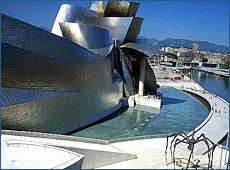|
|
|
|
 |
|
| |
| » |
Barcelona's Sagrada Familia |
» |
Feria de Abril, Seville |
| » |
Prado Museum, Madrid |
» |
Picos de Europa |
| » |
Alhambra Palace – Granada |
» |
Balearic Islands |
| » |
Guggenheim Museum Bilbao |
» |
Cordoba and the Mezquita |
| » |
La Tomatina Festival, Buñol |
» |
Toledo |
|
|
|
 |
| |
| Designed by the North American architect Frank O. Gehry, Guggenheim Museum Bilbao built on a 32,500 square meter site in the center of Bilbao represents an amazing construction feat. On one side it runs down to the waterside of the Nervión River, 16 meters below the level of the rest of the city of Bilbao. One end is pierced through by the huge Puente de La Salve, one of the main access routes into the city. |
| |
| The building of Guggenheim Museum in Bilbao itself is an extraordinary combination of interconnecting shapes. Orthogonal blocks in limestone contrast with curved and bent forms covered in titanium. Glass curtain walls provide the building with the light and transparency it needs. Owing to their mathematical complexity, the sinuous stone, glass, and titanium curves were designed with the aid of computers. The glass walls were made and installed to protect the works of art from heat and radiation. The half-millimeter thick "fish-scale" titanium panels covering most of the building are guaranteed to last one hundred years. As a whole, Gehry's design creates a spectacular, eminently visible structure that has the presence of a huge sculpture set against the backdrop of the city. |
| |
| Visitors passing through the hall to the exhibition areas come immediately to the atrium, the real heart of the Guggenheim Museum in Bilbao and one of the most idiosyncratic features of Gehry's design, which has a sort of metal flower skylight at the top that allows a stream of light to illuminate the warm, inviting space. From the Atrium, the visitor is given the opportunity to access a terrace covered by a canopy supported by a single stone pillar. The canopy serves a function (better appreciated perhaps from the other bank of the river, which offers observers an excellent view of the entire rear façade of the Museum) that is both protective and aesthetic at one and the same time. The broad flight of stairs that goes up to the sculptural tower, conceived as a device to absorb and integrate the Puente de La Salve into the overall architectural scheme of the building, is also a public access way that connects pedestrians with the rest of the city. Exhibition galleries are organized on three levels around the central atrium and are connected by a system of curving walkways suspended from the roof, glass elevators and stair turrets. |
| |
|
|
|



